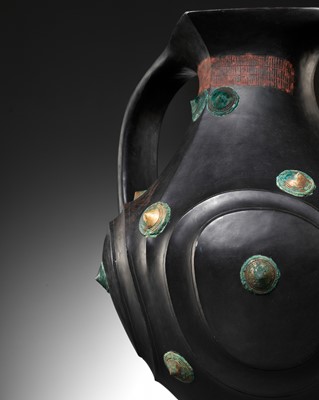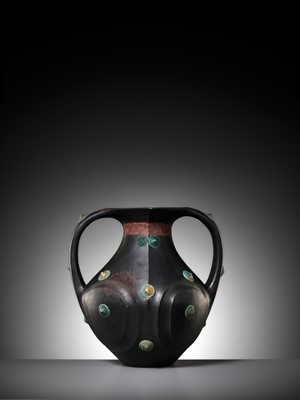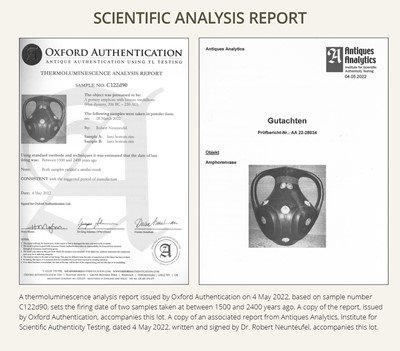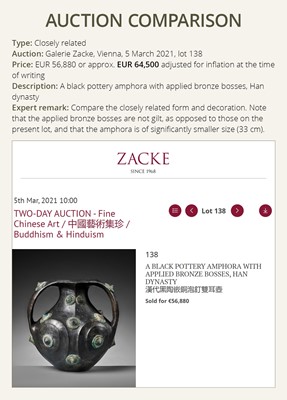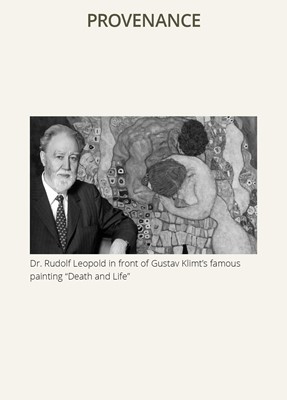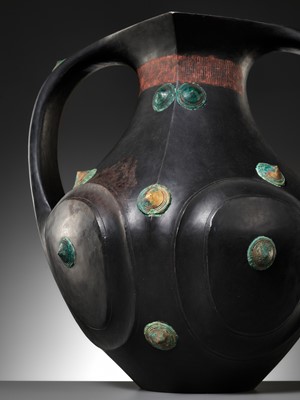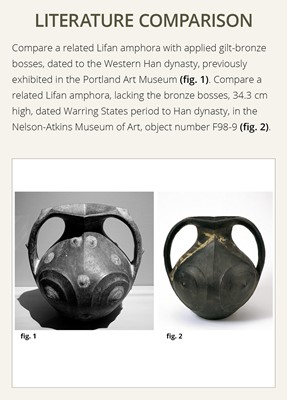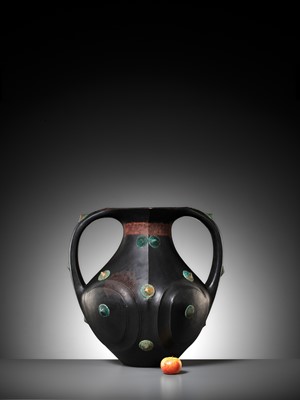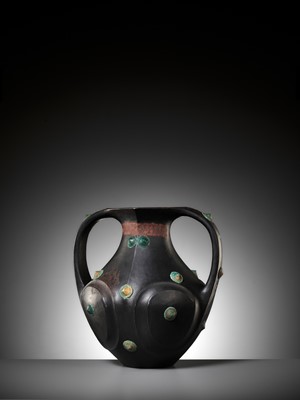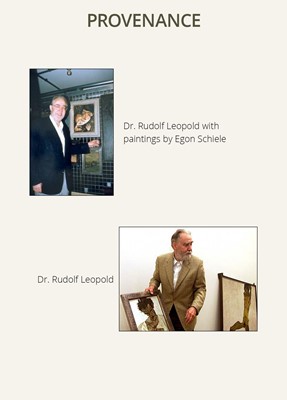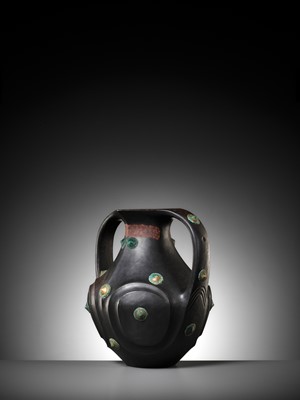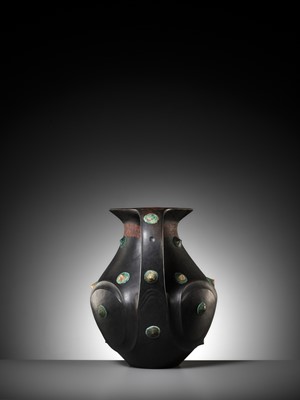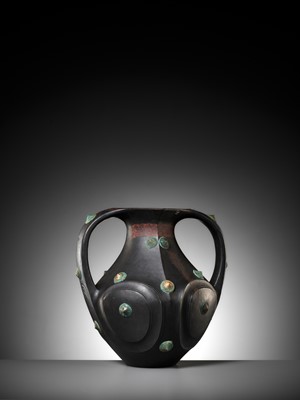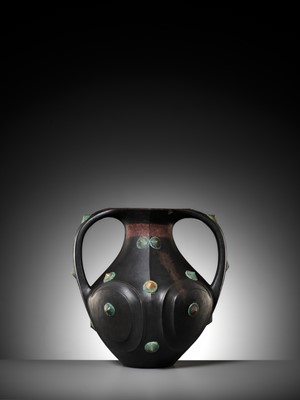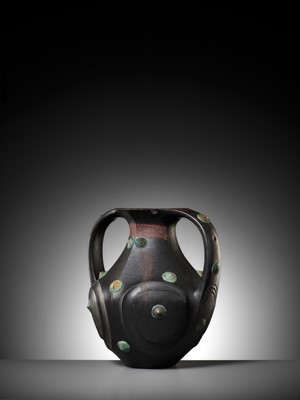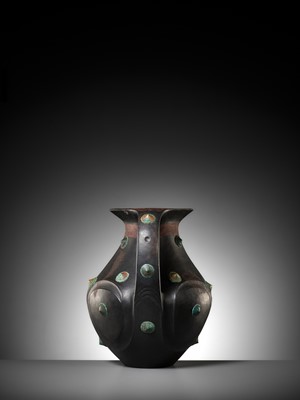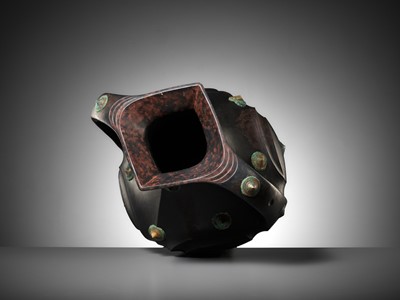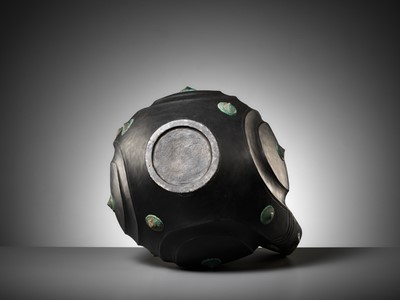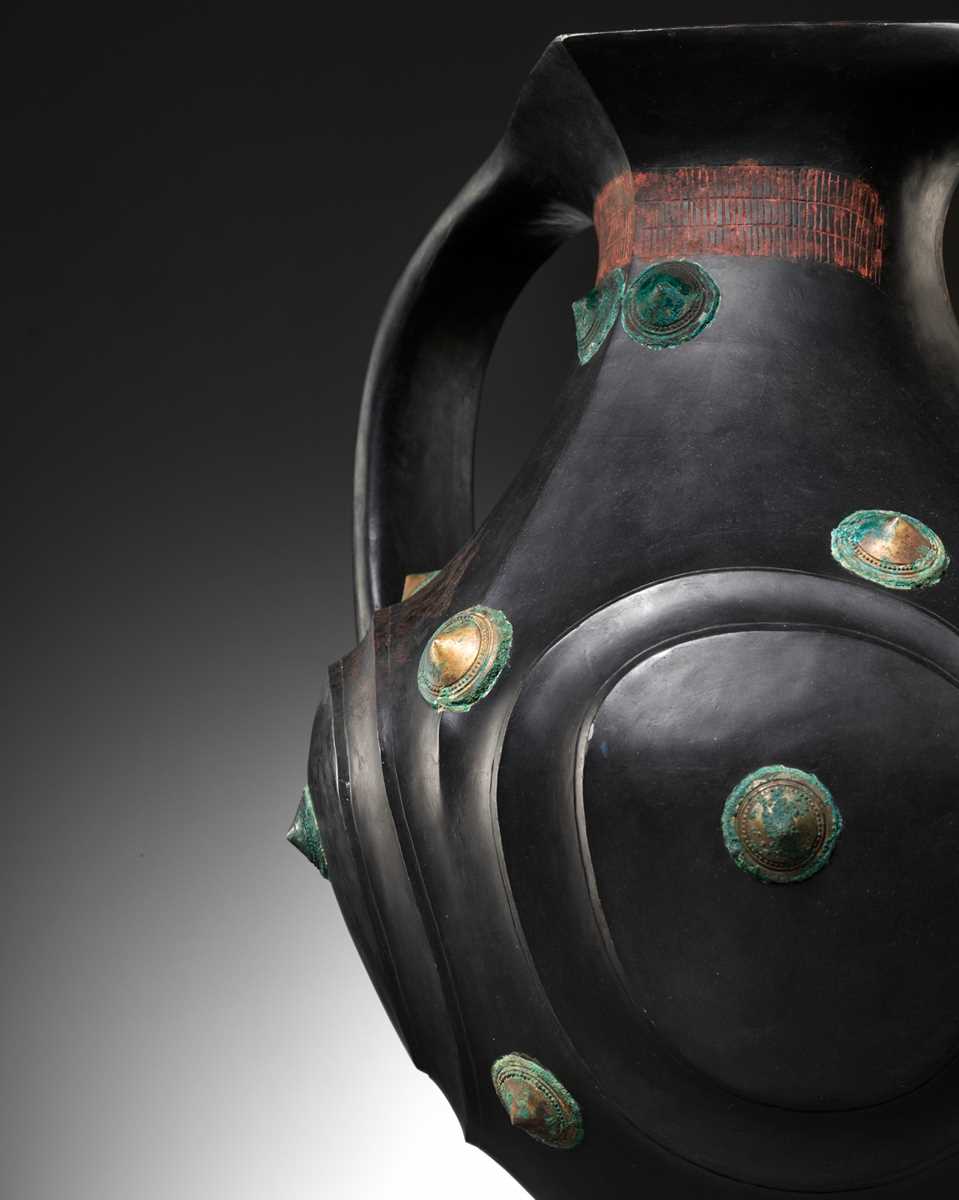9th Mar, 2023 13:00
TWO-DAY AUCTION - Fine Chinese Art / 中國藝術集珍 / Buddhism & Hinduism
62
A VERY LARGE AND RARE BLACK POTTERY AMPHORA WITH APPLIED GILT-BRONZE BOSSES, LIFAN, HAN DYNASTY
漢代黑陶嵌銅泡釘雙耳壺
Sold for €9,100
including Buyer's Premium
Scientific Analysis Report: A thermoluminescence analysis report issued by Oxford Authentication on 4 May 2022, based on sample number C122d90, sets the firing date of two samples taken at between 1500 and 2400 years ago. A copy of the report, issued by Oxford Authentication, accompanies this lot. A copy of an associated report from Antiques Analytics, Institute for Scientific Authenticity Testing, dated 4 May 2022, written and signed by Dr. Robert Neunteufel, accompanies this lot.
China, 202 BC to 220 AD. Heavily potted, the lozenge-form mouth rim tapering to form two wide strap handles above the neck with a finely incised and red-painted striated band to either side, the interior mouth with red paint as well. The ovoid body centered by spiral designs. Applied overall with conical metal bosses with beaded decoration.
Provenance: From the private collection of Dr. Rudolf Leopold, and thence by descent. Dr. Rudolf Leopold (1925-2010) was an Austrian physician and important collector of art. He was born in Vienna and started actively collecting in the mid-1950s, with an early and major focus being works by Egon Schiele, whose paintings were available inexpensively at the time. Leopold acquired a catalog of Schiele's work in 1950 and became enamored with the artist's work, despite the fact that he was distinctly out of fashion. Pieces that he bought for little money would later be worth millions. Other Austrian artists he collected included Gustav Klimt and Oskar Kokoschka. A substantial part of his collection, numbering around 5,000 works of art, was purchased by the Republic of Austria and used as the foundation to create the Leopold Museum, of which the collector was made a director for life. Dr. Rudolf Leopold was also a passionate collector of Chinese works of art.
Condition: Very good condition, commensurate with age. Old wear, minor firing cracks and other irregularities, small nicks here and there, the bosses with malachite and cuprite encrustations, drilled holes from sample-taking, some old repairs and minor touchups, all exactly as expected from an authentic piece with this age.
Weight: 15.8 kg
Dimensions: Height 58.5 cm
The surface of the vessel has been shaped with tools and then burnished. This process of manufacture gives the jar its attractively rugged, yet carefully detailed and distinctive characteristics. The surface of the body is an amalgamation of complex curves with various convex and concave shapes.
This type of black earthenware amphora was produced from the Warring States period and throughout the Han dynasty. It is assumed that the largest versions of these vessels, sumptuously embellished with gilt bronze bosses, were made during the pinnacle of this era, e.g. during the first half of the Han dynasty. As noted by Regina Krahl in Yuegutang, A Collection of Chinese Ceramics in Berlin, 2000, page 55, amphorae of this distinct type are characteristic products of the Western Sichuan province where they were made by non-Chinese peoples. Hence, this type of vessel is known as Lifan, named after the area of Sichuan province in the far west of China, in which such jars have been found.
There are obvious stylistic similarities between these Lifan vessels and objects from much earlier periods such as the Neolithic cultures of Machang (c. 3000-2000 BC) and Xindian (c. 1500-1000 BC). Similar black ware food containers with two handles have also been unearthed in Dena County, Yunan, an area that was the home of the southwestern Yi tribe during the Spring and Autumn period.
Expert’s note: The present lot is an extremely rare example of an enigmatic type of ware. The most striking features of this amphora are its massive size and applied gilt-bronze bosses; the examples recorded in public and private collections are significantly smaller and most lack the bosses. It therefore seems very likely that only very few Lifan amphoras of this size were ever made, and even fewer have survived. In any case, this amphora is the first of its kind to appear on the market in a very long time.
Literature comparison:
Compare a related Lifan amphora with applied gilt-bronze bosses, dated to the Western Han dynasty, previously exhibited in the Portland Art Museum. Compare a related Lifan amphora, lacking the bronze bosses, 34.3 cm high, dated Warring States period to Han dynasty, in the Nelson-Atkins Museum of Art, object number F98-9.
Auction result comparison:
Type: Closely related
Auction: Galerie Zacke, Vienna, 5 March 2021, lot 138
Price: EUR 56,880 or approx. EUR 64,500 adjusted for inflation at the time of writing
Description: A black pottery amphora with applied bronze bosses, Han dynasty
Expert remark: Compare the closely related form and decoration. Note that the applied bronze bosses are not gilt, as opposed to those on the present lot, and that the amphora is of significantly smaller size (33 cm).
漢代黑陶嵌銅泡釘雙耳壺
中國,公元前202年至公元220年。縮頸,壺口外撇,鼓腹,寬大的雙耳從壺口延伸到腹部。壺上鑲嵌泡釘。兩側各有一條紅色條紋,壺内也塗有紅色。
科學檢測報告:隨附牛津熱釋光檢測報告複印本,根據樣本C122d90,2022年5月4日測試結果,該拍品應爲1500-2400年前所製。隨附一份2022年5月4日由科學檢測研究所Dr. Robert Neunteufel出具的檢測報告複印本。
來源:Rudolf Leopold醫生私人收藏,保存至今。Rudolf Leopold (1925-2010年) 是一位奧地利醫生和重要藝術品收藏家。他出生於維也納,並於二十世紀五十年代中期開始積極收藏,早期主要關注埃貢·席勒 (Egon Schiele) 的作品,其畫作在當時並不昂貴。Leopold 於 1950 年獲得了席勒 (Schiele) 的作品目錄,並迷上了這位藝術家的作品,儘管他明顯已經過時了。他花很少錢買的東西後來價值數百萬。他收藏的其他奧地利藝術家包括 Gustav Klimt 和 Oskar Kokoschka。奧地利購買了他的大部分藏品,約有 5,000 件藝術品,並以此為基礎創建了Leopold博物館,Leopold成為該博物館的終身館長。Rudolf Leopold醫生也是一位熱衷於收藏中國藝術品的人。
品相:狀況良好,有磨損和鑄造缺陷,到處都有小缺口,銅綠包漿與結殼。因爲檢測進行樣品採集而鑽孔,一些缺損和小修,與其年代相符。
重量:15.8 公斤
尺寸:高58.5 厘米
容器的表面已經用工具打磨,使壺更加堅固,同時還具有細緻入微和與眾不同的特點。壺身表面具有各種凸凹形狀的複雜曲線。
這種黑陶雙耳壺從戰國到整個漢代都有生產。據推測,這些器皿凸台,是在這個時代的巔峰時期製造的,例如漢朝上半期。 正如 Regina Krahl 在《悅古堂-柏林中國陶瓷收藏》,2000 年,第 55 頁所指出的,這種獨特類型的雙耳瓶是四川西部省份的特有創作,以中國最西部的四川省地區命名。
這些器皿與更早時期的器物在風格上有明顯的相似之處,例如馬廠(約公元前 3000-2000 年)和新店(約公元前 1500-1000 年)的新石器時代文化,春秋時期西南彝族聚居地雲南德納縣也曾出土過類似的雙柄黑瓷食器。
專家注釋:本拍品是極為罕見的神祕器皿。 這款雙耳壺最顯著的特點是其巨大的尺寸和鍍金青銅凸起部位;在公共和私人收藏中記錄的例子很少。此類器皿留存下來的很少了,這也是很長一段時間以來首次出現在市場上的同類產品。
文獻比較:
比較相近的西漢黑陶嵌銅泡釘雙耳壺,先前展覽於波特蘭藝術博物館。比較相近的戰國至漢代黑陶雙耳壺,高34.3 厘米 ,收藏於納爾遜-阿特金斯藝術博物館,館藏編號F98-9。
拍賣結果比較:
形制:非常相近
拍賣:維也納Galerie Zacke,2021年3月5日,lot 138
價格:EUR 56,880(相當於今日EUR 64,500)
描述:漢代黑陶嵌銅泡釘雙耳壺
專家評論:比較非常相近的外形和裝飾。請注意銅泡釘沒有鎏金,與本拍品相比,尺寸 (33 厘米)較小。
Scientific Analysis Report: A thermoluminescence analysis report issued by Oxford Authentication on 4 May 2022, based on sample number C122d90, sets the firing date of two samples taken at between 1500 and 2400 years ago. A copy of the report, issued by Oxford Authentication, accompanies this lot. A copy of an associated report from Antiques Analytics, Institute for Scientific Authenticity Testing, dated 4 May 2022, written and signed by Dr. Robert Neunteufel, accompanies this lot.
China, 202 BC to 220 AD. Heavily potted, the lozenge-form mouth rim tapering to form two wide strap handles above the neck with a finely incised and red-painted striated band to either side, the interior mouth with red paint as well. The ovoid body centered by spiral designs. Applied overall with conical metal bosses with beaded decoration.
Provenance: From the private collection of Dr. Rudolf Leopold, and thence by descent. Dr. Rudolf Leopold (1925-2010) was an Austrian physician and important collector of art. He was born in Vienna and started actively collecting in the mid-1950s, with an early and major focus being works by Egon Schiele, whose paintings were available inexpensively at the time. Leopold acquired a catalog of Schiele's work in 1950 and became enamored with the artist's work, despite the fact that he was distinctly out of fashion. Pieces that he bought for little money would later be worth millions. Other Austrian artists he collected included Gustav Klimt and Oskar Kokoschka. A substantial part of his collection, numbering around 5,000 works of art, was purchased by the Republic of Austria and used as the foundation to create the Leopold Museum, of which the collector was made a director for life. Dr. Rudolf Leopold was also a passionate collector of Chinese works of art.
Condition: Very good condition, commensurate with age. Old wear, minor firing cracks and other irregularities, small nicks here and there, the bosses with malachite and cuprite encrustations, drilled holes from sample-taking, some old repairs and minor touchups, all exactly as expected from an authentic piece with this age.
Weight: 15.8 kg
Dimensions: Height 58.5 cm
The surface of the vessel has been shaped with tools and then burnished. This process of manufacture gives the jar its attractively rugged, yet carefully detailed and distinctive characteristics. The surface of the body is an amalgamation of complex curves with various convex and concave shapes.
This type of black earthenware amphora was produced from the Warring States period and throughout the Han dynasty. It is assumed that the largest versions of these vessels, sumptuously embellished with gilt bronze bosses, were made during the pinnacle of this era, e.g. during the first half of the Han dynasty. As noted by Regina Krahl in Yuegutang, A Collection of Chinese Ceramics in Berlin, 2000, page 55, amphorae of this distinct type are characteristic products of the Western Sichuan province where they were made by non-Chinese peoples. Hence, this type of vessel is known as Lifan, named after the area of Sichuan province in the far west of China, in which such jars have been found.
There are obvious stylistic similarities between these Lifan vessels and objects from much earlier periods such as the Neolithic cultures of Machang (c. 3000-2000 BC) and Xindian (c. 1500-1000 BC). Similar black ware food containers with two handles have also been unearthed in Dena County, Yunan, an area that was the home of the southwestern Yi tribe during the Spring and Autumn period.
Expert’s note: The present lot is an extremely rare example of an enigmatic type of ware. The most striking features of this amphora are its massive size and applied gilt-bronze bosses; the examples recorded in public and private collections are significantly smaller and most lack the bosses. It therefore seems very likely that only very few Lifan amphoras of this size were ever made, and even fewer have survived. In any case, this amphora is the first of its kind to appear on the market in a very long time.
Literature comparison:
Compare a related Lifan amphora with applied gilt-bronze bosses, dated to the Western Han dynasty, previously exhibited in the Portland Art Museum. Compare a related Lifan amphora, lacking the bronze bosses, 34.3 cm high, dated Warring States period to Han dynasty, in the Nelson-Atkins Museum of Art, object number F98-9.
Auction result comparison:
Type: Closely related
Auction: Galerie Zacke, Vienna, 5 March 2021, lot 138
Price: EUR 56,880 or approx. EUR 64,500 adjusted for inflation at the time of writing
Description: A black pottery amphora with applied bronze bosses, Han dynasty
Expert remark: Compare the closely related form and decoration. Note that the applied bronze bosses are not gilt, as opposed to those on the present lot, and that the amphora is of significantly smaller size (33 cm).
漢代黑陶嵌銅泡釘雙耳壺
中國,公元前202年至公元220年。縮頸,壺口外撇,鼓腹,寬大的雙耳從壺口延伸到腹部。壺上鑲嵌泡釘。兩側各有一條紅色條紋,壺内也塗有紅色。
科學檢測報告:隨附牛津熱釋光檢測報告複印本,根據樣本C122d90,2022年5月4日測試結果,該拍品應爲1500-2400年前所製。隨附一份2022年5月4日由科學檢測研究所Dr. Robert Neunteufel出具的檢測報告複印本。
來源:Rudolf Leopold醫生私人收藏,保存至今。Rudolf Leopold (1925-2010年) 是一位奧地利醫生和重要藝術品收藏家。他出生於維也納,並於二十世紀五十年代中期開始積極收藏,早期主要關注埃貢·席勒 (Egon Schiele) 的作品,其畫作在當時並不昂貴。Leopold 於 1950 年獲得了席勒 (Schiele) 的作品目錄,並迷上了這位藝術家的作品,儘管他明顯已經過時了。他花很少錢買的東西後來價值數百萬。他收藏的其他奧地利藝術家包括 Gustav Klimt 和 Oskar Kokoschka。奧地利購買了他的大部分藏品,約有 5,000 件藝術品,並以此為基礎創建了Leopold博物館,Leopold成為該博物館的終身館長。Rudolf Leopold醫生也是一位熱衷於收藏中國藝術品的人。
品相:狀況良好,有磨損和鑄造缺陷,到處都有小缺口,銅綠包漿與結殼。因爲檢測進行樣品採集而鑽孔,一些缺損和小修,與其年代相符。
重量:15.8 公斤
尺寸:高58.5 厘米
容器的表面已經用工具打磨,使壺更加堅固,同時還具有細緻入微和與眾不同的特點。壺身表面具有各種凸凹形狀的複雜曲線。
這種黑陶雙耳壺從戰國到整個漢代都有生產。據推測,這些器皿凸台,是在這個時代的巔峰時期製造的,例如漢朝上半期。 正如 Regina Krahl 在《悅古堂-柏林中國陶瓷收藏》,2000 年,第 55 頁所指出的,這種獨特類型的雙耳瓶是四川西部省份的特有創作,以中國最西部的四川省地區命名。
這些器皿與更早時期的器物在風格上有明顯的相似之處,例如馬廠(約公元前 3000-2000 年)和新店(約公元前 1500-1000 年)的新石器時代文化,春秋時期西南彝族聚居地雲南德納縣也曾出土過類似的雙柄黑瓷食器。
專家注釋:本拍品是極為罕見的神祕器皿。 這款雙耳壺最顯著的特點是其巨大的尺寸和鍍金青銅凸起部位;在公共和私人收藏中記錄的例子很少。此類器皿留存下來的很少了,這也是很長一段時間以來首次出現在市場上的同類產品。
文獻比較:
比較相近的西漢黑陶嵌銅泡釘雙耳壺,先前展覽於波特蘭藝術博物館。比較相近的戰國至漢代黑陶雙耳壺,高34.3 厘米 ,收藏於納爾遜-阿特金斯藝術博物館,館藏編號F98-9。
拍賣結果比較:
形制:非常相近
拍賣:維也納Galerie Zacke,2021年3月5日,lot 138
價格:EUR 56,880(相當於今日EUR 64,500)
描述:漢代黑陶嵌銅泡釘雙耳壺
專家評論:比較非常相近的外形和裝飾。請注意銅泡釘沒有鎏金,與本拍品相比,尺寸 (33 厘米)較小。
Zacke Live Online Bidding
Our online bidding platform makes it easier than ever to bid in our auctions! When you bid through our website, you can take advantage of our premium buyer's terms without incurring any additional online bidding surcharges.
To bid live online, you'll need to create an online account. Once your account is created and your identity is verified, you can register to bid in an auction up to 12 hours before the auction begins.
Intended Spend and Bid Limits
When you register to bid in an online auction, you will need to share your intended maximum spending budget for the auction. We will then review your intended spend and set a bid limit for you. Once you have pre-registered for a live online auction, you can see your intended spend and bid limit by going to 'Account Settings' and clicking on 'Live Bidding Registrations'.
Your bid limit will be the maximum amount you can bid during the auction. Your bid limit is for the hammer price and is not affected by the buyer’s premium and VAT. For example, if you have a bid limit of €1,000 and place two winning bids for €300 and €200, then you will only be able to bid €500 for the rest of the auction. If you try to place a bid that is higher than €500, you will not be able to do so.
Online Absentee and Telephone Bids
You can now leave absentee and telephone bids on our website!
Absentee Bidding
Once you've created an account and your identity is verified, you can leave your absentee bid directly on the lot page. We will contact you when your bids have been confirmed.
Telephone Bidding
Once you've created an account and your identity is verified, you can leave telephone bids online. We will contact you when your bids have been confirmed.
Classic Absentee and Telephone Bidding Form
You can still submit absentee and telephone bids by email or fax if you prefer. Simply fill out the Absentee Bidding/Telephone bidding form and return it to us by email at office@zacke.at or by fax at +43 (1) 532 04 52 20. You can download the PDF from our Upcoming Auctions page.
How-To Guides
How to Create Your Personal Zacke Account
How to Register to Bid on Zacke Live
How to Leave Absentee Bids Online
How to Leave Telephone Bids Online
中文版本的操作指南
创建新账号
注册Zacke Live在线直播竞拍(免平台费)
缺席投标和电话投标
Third-Party Bidding
We partner with best-in-class third-party partners to make it easy for you to bid online in the channel of your choice. Please note that if you bid with one of our third-party online partners, then there will be a live bidding surcharge on top of your final purchase price. You can find all of our fees here. Here's a full list of our third-party partners:
- 51 Bid Live
- EpaiLive
- ArtFoxLive
- Invaluable
- LiveAuctioneers
- the-saleroom
- lot-tissimo
- Drouot
Please note that we place different auctions on different platforms. For example, in general, we only place Chinese art auctions on 51 Bid Live.
Bidding in Person
You must register to bid in person and will be assigned a paddle at the auction. Please contact us at office@zacke.at or +43 (1) 532 04 52 for the latest local health and safety guidelines.
